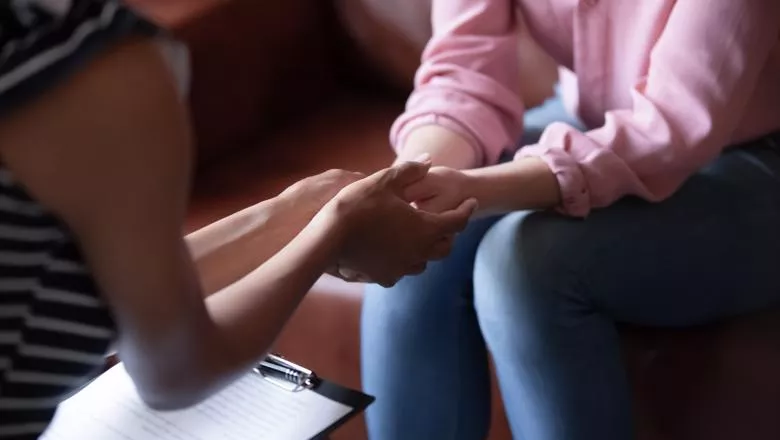This report gives us a solid framework to focus our actions and ensure that nobody’s story remains hidden. As we emerge from lockdown it is vital that we all reach out to these children and young people. We need to start a global social conversation that raises awareness of how to recognise and respond to abuse.
Co-author Laura E Fischer
08 March 2021
Survivor-led report highlights urgent need to recognise and help children and young people at risk of abuse during COVID-19 and beyond
As children go back to school in England today, Monday 8th March, a new a survivor-led report is being launched by Survivors’ Voices and King’s College London. The report, 'Safe Seen Supported', focuses on supporting ‘off-radar’ children and young people experiencing, or at risk of, abuse in their households during the COVID-19 pandemic and beyond.

The report, ‘Safe Seen Supported’, highlights three key recommendations that schools, nurseries and childcare settings need to focus on to mitigate harm and prevent children experiencing abuse:
- Educate children and young people about abuse. This includes providing age-appropriate information and resources on supporting at-risk friends.
- Allocate regular check-ins with a child or young person to teachers who have a good rapport with them to maximise the chances of disclosures.
- Train teachers and provide them with guidance on how to identify the signs of household violence/abuse, and sensitively ask questions and respond to disclosures.
The work was carried out in partnership with Survivors’ Voices, Laura E Fischer, the UKRI Violence Abuse and Mental Health Network (VAMHN), and the McPin Foundation.
It was created by survivor researchers Laura E Fischer, Dr Angela Sweeney from King’s College London, Jane Chevous and Concetta Perôt, Co-founders of Survivors’ Voices, to capture the experiences and wisdom of those who know best how to support off-radar children and young people experiencing abuse: adults who were once these children and practitioners who support survivors.
Many children and young people who are experiencing, or are at risk of, various forms of abuse in their households never come to the attention of authorities. It is estimated that 1 in 5 children is subjected to at least one form of child abuse (physical, sexual, emotional, neglect, exposure to domestic abuse) before the age of 16 (1) – much of this abuse is ‘off-radar’, that is, unknown to statutory services. UNICEF (2014) affirms that child abuse is vastly concealed and under-reported (2).
Co-author Laura E Fischer says: “When the first lockdown was announced in March 2020, we were deeply impacted by the thought of children and young people trapped in abusive households, away from the support of school or friends.
“We knew that most of these children and young people would be ‘off-radar’ and unknown to services and thus not identified and supported by government initiatives. Children and young people experiencing abuse tend to already be very isolated.
In addition to a rapid-response online survey which was published in April 2020 during the first lockdown, the team undertook a further online survey completed by 71 survivors and those who support them plus virtual roundtable discussions with 37 survivors, practitioners and creative communicators to gain a deeper understanding of how children experiencing abuse may feel and how best to support them.
Jane Chevous, study co-researcher said:
“School was my safe place, with adults who I knew wouldn't harm me. I remember one teacher, who read my poems and encouraged me to write stories. She could see that I was scared and unhappy, although I couldn't find the words to tell her why at the time. Her kindness and caring showed me that I mattered, that there was hope.
Our report is a call to action to government and services like schools to take urgent steps to help children in a situation like I was growing up. But it also suggests practical things we can all do, to help children trapped in abusive situations. We can notice the children in our neighbourhood, our circle of family and friends. We can find ways to show them we care. We can let them know they matter, that there is hope.
Jane Chevous, study co-researcher
Key findings from the report include:
- It is everyone’s responsibility to protect children and young people from abuse.
- People often do not know how to recognise abuse and/or do not feel able to do something about it. We need to support friends, family, community members and practitioners to notice and deal with abuse, and to know how to do this sensitively.
- Children and young people have difficulty recognising that what they are experiencing is abuse as that is the reality they know. This is one of several barriers to disclosure.
- Because children and young people’s experiences are what they know to be normal, they often do not identify with words such as ‘abuse’, ‘neglect’, violence’. Therefore, a wider range of language must be used.
- There are three types of safety: being safe from harm (physical safety) feeling safe with others (relational safety) and feeling safe in oneself (internal safety). All are important and all must be nurtured.
- For physical safety, children and young people need to have access to safe places away from harm in the community; at school, in youth services and in mental health services. For relational safety, children and young people need to have access to trustworthy people. With physical safety and relational safety, they can begin to experience internal safety.
- We must ensure children and young people are heard, in control, and supported. For this, we must be present and accessible, creating a safe relational environment where disclosure could happen. Then, we must listen, offer reassurance and clear information on what their options are and follow their lead as much as possible.
- It is important that all interventions are carefully considered and that none of the actions taken replicate dynamics of abuse. We must actively reinforce children and young people’s voice, control, and power: that is the only way out of abuse and toward safety and healing.
Linked to this report is a brief visual guidance to help young people and their friends to seek advice and support if they are feeling unsafe, trapped or unloved in their family or are concerned about a friend who may be feeling this way.
The pandemic has been a toxic situation for many children and young people, placing them at a dramatically increased risk of experiencing violence and abuse, with potentially disastrous effects on their mental health. We hope that the recommendations outlined in this report will assist those close to them to help.
Dr Sian Oram from the Institute of Psychiatry, Psychology & Neuroscience (IoPPN), King’s College London, and Director of the Violence Abuse and Mental Health Network
The full report can be found here.
For further information please contact IoPPN Press Office: ioppn-pr@kcl.ac.uk
The study is supported by the King’s COVID Appeal Fund and the Economic and Social Research Council Impact Acceleration Account at King’s College London. The Violence Abuse and Mental Health Network is funded by UK Research and Innovation.
- ONS (Office of National Statistics). Statistical bulletin: Child abuse in England and Wales: March 2020. Statistics and research on child abuse in England and Wales, bringing together a range of different data sources from across government and the voluntary sector. ONS March 2020. https://www.ons.gov.uk/peoplepopulationandcommunity/crimeandjustice/bulletins/childabuseinenglandandwales/march2020
- UNICEF (2014). Hidden in Plain Sight: A Statistical Analysis of Violence Against Children. New York: United Nations Children’s Fund.

